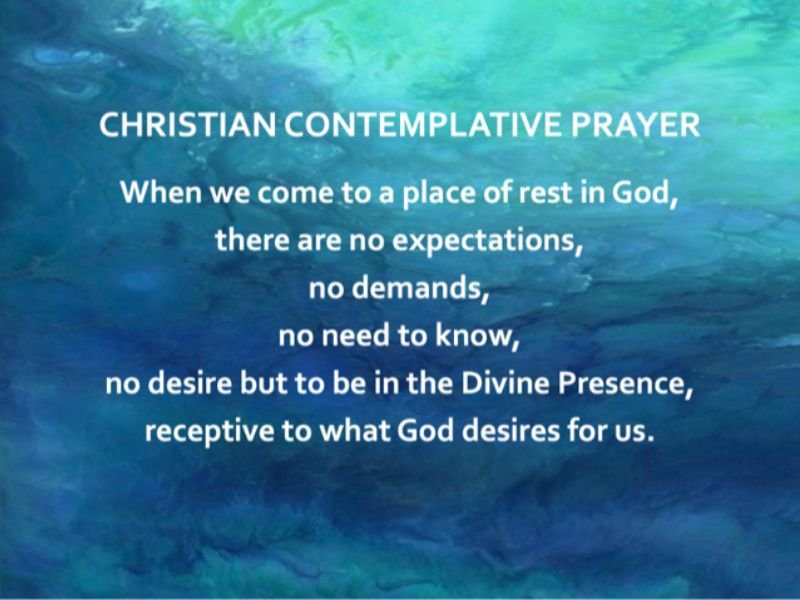Intro to Centering Prayer: Opening to God’s Presence
Centering Prayer or Christian Contemplative Prayer has been practiced since the time of Jesus.
Meditation: Pathway to Divine Love
In a world of increasing divisiveness and deception, it is becoming crucial that we rediscover our spiritual dimension and its energies, especially that of love. Meditation is the way to do this. Through the practice of meditation, all that impedes our capacity to love unconditionally is slowly but surely uprooted and dissipated. From within our deepest being, divine love begins to flow freely into and through us, rippling out to touch our circumstances and our relationships with its healing and wisdom and guidance. This tapping of the divine love that lies within the innermost core of all beings will be one of the first and ongoing fruits of our meditation practice.
As we continue to practice daily, the flow of this pure, ever present spiritual love into our daily life evolves into a new, more expanded sense of relationship – of community – in which we experience our interconnectedness with others and with all of life. The hard shell of our sense of separateness and isolation and
And so, the divine Love at our innermost core that we access via our practice of meditation gives birth to all the fruit of Spirit in our life: joy, peace, patience, kindness, goodness, faithfulness, gentleness, and temperance (Galatians 5:22-23). In this way, contemplative prayer is nothing short of transformational, transforming both ourselves and our world from the inside out.
What? Christianity has a Tradition of Meditation??
Yes! There is a very rich history of meditation in Christianity. Traditionally, it is called centering prayer or contemplative prayer and it has been practiced since the time of Jesus. In recent years, a more contemporary version of contemplative prayer has been introduced, called Centering Prayer. (See my blog post on A History of Contemplative Prayer.) The name “Centering Prayer” comes from Father Thomas Merton, a 20th-century monk who spoke of contemplative prayer as “centered” entirely in the presence of God.
So just what is contemplative prayer? We typically think of prayer as thoughts or feelings expressed in words toward God,[1] but when we pray contemplatively, we move beyond words and thoughts. We’re not speaking to God with words or thinking about God the way we usually do when we pray.
In centering prayer, we go to an even deeper level – we move out of our head and into the core of our spiritual heart, and we rest there in silence and in stillness, in the Presence of God. We enter into this “Holy of Holies” at the innermost core of our being where we are one with God and God is one with us. There, we simply rest in Divine Presence — we simply open in awe to this Holy Mystery – our True and Eternal Home.
Centering prayer is the process of moving beyond all our thoughts and emotions, and even beyond our usual psychological sense of ourselves, so that we may open to God's infinite Presence at our innermost core. Practicing centering prayer teaches us how to open the aperture of our awareness from a tightly focused self-centeredness to a wide angled God-centeredness.
During our practice of centering prayer, we simply move beyond the confines of our ordinary awareness and sink into the infinite, pure awareness within our heart of hearts – we merge back into our true nature within and at one with Divine Love. We steep ourselves in Divine Love. And in doing so, we are transformed. This mysterious transformation is the inner awakening that Centering Prayer is all about.
Oil painting by Josef Kote, “Letting Go,”
We begin to live with an awareness of being in the presence of God at all times and in all places. This brings a much more open and spacious and loving dimension to our lives; it brings a new depth of holiness to everything we do and to everything that happens in our lives. We come into intimate relationship with God.
Centering Prayer is Really Quite Simple
Over the years, Christian monks and other practitioners of Centering Prayer developed a simple four-step set of instructions for practicing this method of prayer:
Practicing Centering Prayer
Choose a sacred word as a symbol of your intention to consent to God’s presence and action within you. (e.g. Love, I Am, Christ, Be Still, Peace, etc.)
Sitting comfortably with your eyes closed, settle briefly and silently begin to repeat your sacred word.
When you find yourself caught up in thoughts, simply and gently return to repeating your sacred word.
At the end of your prayer period, remain in silence with eyes closed for a couple of minutes
At the end of your prayer period, remain in silence with eyes closed for a couple of minutes..
That’s all there is to it. Father Thomas Keating pointed out that “the only thing you can do wrong in this prayer is to get up and walk out!” There is no way to succeed or fail. It’s simply being in God’s Presence within you and allowing that to work in and through you. Remember: centering prayer is not about “hearing” from God or talking to God; rather, its point is to practice surrender of our small ego self to the infinite Presence of God. Every time you realize that you have gotten caught up in thoughts, you simply re-open the aperture of your awareness so that you may return to being in God’s Presence in your heart of hearts.
So, during your time of centering prayer, whenever you get swept up in a stream of thoughts, you simply return to repeating your sacred word as a powerful symbol of your willingness to let go of your own self-focus and remain open to the Presence of God. Understand that it really doesn’t matter which word you use; rather, it’s your intention that will make it sacred, and its power will come from your consistent repetition of it. At the end of your prayer period, remain in silence with your eyes closed for a couple of minutes as you bring your attention back to the outer world.
It is recommended that you practice centering prayer for 20-30 minutes each day. If that feels like too much for you in the beginning, then start with 5-10 minutes. With regular practice, you will be transformed.
Listen to Dr. Jana Rentzel’s Guided Christian Meditations
and/or attend her weekly class Living in Divine Presence live on Zoom.
Guided Christian Meditations
You can experience Christian centering prayer by listening to one of our guided Christian meditations.
Stillness with God Meditation - This guided meditation provides you with an opportunity to pause from the many activities of your daily life and to focus on God – to be still in the presence of God, to “be still and know God.”
Meditation on Divine Love - This meditation will help you to access the infinite source of unconditional spiritual love that lies deep within you, allowing it to heal you from within and ripple out to touch all others in your life.
Finding Peace Meditation - A guided meditation to help you access the peace that abides at your innermost core that is always there for you,
Cultivating Love and Peace - A guided meditation to help you experience the Divine Love and Peace at your innermost core and then to extend this ever-present love and peace to others. Living from this place of Divine Love and Peace will transform both yourself and your world..
Additional Resources on Contemplative Christian Prayer
Laurence Freeman OSB, Benedictine monk and director of the World Community for Christian Meditation, skillfully describes the art and purpose of Christian meditation.
[1] While I frequently use the word “God” to refer to the Ultimate Divine Reality, please note that I could just as easily use any number of other terms (e.g., the Absolute, Buddha nature, Higher Power, Allah, Yahweh, Divine Mother, Great Spirit, etc.), so please substitute whatever term for Ultimate Mystery with which you are most comfortable.










The ability to live with a clear and direct awareness of Divine Presence is available to everyone, not just to prophets and mystics. Developing this ability lies at the heart of all the great spiritual traditions of the world, including the western traditions.